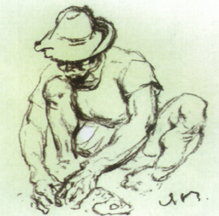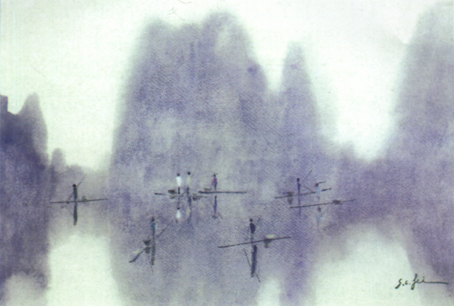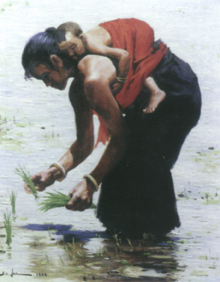 Fisherman 渔民
LI RUIXIANG 李瑞祥 (°1941).
1963. Charcoal on paper. 24.0 cm × 24.0 cm.
Fisherman 渔民
LI RUIXIANG 李瑞祥 (°1941).
1963. Charcoal on paper. 24.0 cm × 24.0 cm.
The painter Li Ruixiang• was born in Guilin• in 1941. His birthplace is internationally reputed for the picturesqueness of its landsape, an inexautible source of inspiration for Chinese painters. Since his early years Li felt a special attraction for the local river Li his namesake. As a young boy he used to spend all his free time following the painters by the riverside, their contemplating and studying in silence, their handling of the brush and their colouring techniques. It was in his region that Li made the first steps towards developing his pictorial skills and learning about art in general. Thanks to his early artistic talents in both primary and secondary school he was elected the head of the Xuexibu• (Study Section) of the school's Xueshengui• (Students Union). He was repeatedly awarded top marks in all subjects related to the visual arts and won awards in the all painting competitions in which he participated.
In 1951, ten years old, he had one of his works selected to participate in the Children's International Exhibition of Painting which that year took place in Budapest.
After secondary school he attended the Guangzhou Meishu Xueyuan Fushu Zhongxue• (Preparatory School of the Guangzhou Institute of Painting), where for three intense years he studied the practical and theoretical principles of the Chinese fine arts. Graduating from this course with the maximum possible qualification, he was advised to train even further and enroll in China's most prestigious art academy, the Guangzhou Meishu Xueyuan• (Guangzhou Institute of Painting). After his first year of studies there he decided to spend the summer holidays painting a cartoon series entitled "Xiangjiang niliu"• ("Struggling Against the Xiang River Current") which was later published by the Shanghai Remin Meishu Chubanshe• (Shanghai People's Publishing House) and gained a reputation throughout China.
Being a student of extremely modest means during those years in Guangzhou and not having enough money to buy canvas, he used his bed sheets to paint on.
In 1964, during his third year of studies at the Guangzhou Institute, his work entitled "Fenshou jijie" •("Times of Plenty") was selected for the Disi jie quanguo meizhan• (Fourth National Exhibition of Painting). During five years of study at the Institute he consistently obtained the highest marks and praise from the critics. The artistic progress made during these years was remarkable, as can be testified by chronological comparison of his paintings, made possible by frequent publication in thematic periodicals of the time. His post-graduation painting entitled "Haitan"• ("Beach") was widely acclaimed by critics and the general public alike.
After leaving the Institute in 1965 he joined the Guangdong sheng bowuguan• (Guangdong Provincial Museum) which houses a collection of precious art treasures. The gradually achieved familiarity with such exquisite objects greatly contributed to the further enrichment of his knowledge of the arts of China. Aware of Li's qualities the museum staff supported his learning interests and frequently allowed him to joined archeological excavations. One of the most exciting in which he participated was that of the unearthing of the ruins of a citadel of the Maba• people, an ethnic group which lived over a hundred thousand years ago on the shores of the Qu• river.
 Fishing Boats on the Lijiang River 漓江渔筏
LI RUIXIANG 李瑞祥 (°1941).
1985. Gouache on canvas. 63.0 cm × 43.0 cm.
Fishing Boats on the Lijiang River 漓江渔筏
LI RUIXIANG 李瑞祥 (°1941).
1985. Gouache on canvas. 63.0 cm × 43.0 cm.
At the museum Li was constantly busy with the preservation of the national heritage and coordinating exhibitions with a wide range of subjects: traditional painting, national heritage objects and socio-historical themes. In order to assemble material for the preparation of these exhibitions he traveled widely in China and visited a number of distant archeological sites, such as those of the Beijing• people and the Shanding Dongren• (Cave of the Peak),• Southeast of Beijing. These travels sometimes required his staying at site for a number of months to inventory in loco the recently excavated objects. During one such stay at the archeological site of the primitive Banpo• culture, near Xian• in Shaanxi• province, inspired by what he was seeing, he took the opportunity to make a series of paintings depicting the lifestyle of this primitive society. Some of these paintings entitled "Shizu huiyi"• ("The General Assembly of the Matriarchal Society"), "Jiazhang yu nuli" ("Rulers and Slaves"), and "Nuli qiyi" ("The Slaves Revolt") were widely praised by the academic world as well as the critics.
Li's deep interest in the culture heritage of China prompted him to study a wide range of objects systematically in the Guangdong Provincial Museum collection as well as some architectural buildings of historical importance; such as Sun Zhongshan• (Sun Iat Sen)'s family house in Cuiheng• village, the headquarters of the Zhongguo Guomindang Diyi Ci Quanguo Daibiao Dahui• (The First General Assembly of the Nationalist Party) in Jinggang• mountain, and the birthplace o of Lu Xun• in Jaoqing.• For more than a decade Li used visual information and direct experiences from these site visits to structure pictorial compositions such as "Taiping Tianguo gonga Guilin"• ("The Fight of the Heavenly Rule of the Taiping in Guilin"), "Guangzhouwang renmin kangfa douzheng"•("The People' Fight against Facism at Guangdong Bay"), "Guangzhou jiyi"• ("The Guangzhou Revolution"), "Sun Zhongshan Yanjiang Sanmin Zhuyi" ("Sun Zhongshan's Intervention and the People's Three Leading Principles"), "Zhongguo Guomindang Diyi Ci Quanguo Daibiao Dahui" ("The First General National Assembly of the Members of the National Party of China"), "Jinggangshan huishi" ("The Meeting of the Armies at the Jinggang Mountain") and many others. Most of Li's patriotic works of this era now belong to the Chinese museums' collections.

Woman Farmer and Child 农妇与孩子
LI RUIXIANG 李瑞祥 (°1941).
1989. Oil on canvas. 60.0 cm × 80.0 cm.
After the Shinian haojie• ('Ten Year Calamity') the country was devastated and in ruins. In order to promote the rebirth of painting in Guangdong province Li and some friends decided to create the Guangdong youhua yanjiuhui• (Association for the Study of Oil Painting of the Guangdong Province). Li was elected secretary-general of the newly born Association, in charge of coordinating the daily events and one of his major tasks was to organize paintings exhibitions in Guangdong. He also contributed towards a greater appreciation of oil painting encouraging theoretical research into this medium. His merits as Man and Artist, greatly praised and admired by his colleagues friends, won him election as the artists' representative in the Guangdong sheng wenxue yishujia daibiao dahui• (General Assembly of the Scholars and Artists of the Guangdong Province), executive member of the Guangdong sheng meishu zhongxin• (Association of Painters of the Guangdong Province), director of the Guangdong meishujia zhongxin• (Painting Centre of the Guangdong Province) and member of the board of a number of museums in Guangdong province. He carried these numerous functions with great tolerance and pragmatism and with a calm and understanding which won him widespread recognition.
Having more time to dedicate to his painting after settling in Macao, he decided to continue with his experiments in composition of historical meaning. The development of these pursuits achieved works such as "Jinghu yixi"• ("The Kiangwu Hospital Volunteers") and "Puguohun"• ("The Lusiads"). He also portrayed a number of important figures from Portugal, China and Macao's public life, including the former President of the Portuguese Republic General Ramalho Eanes, the former Archbishop of the Macao Bishophry Dom Arquimínio da Costa, former Governors of Macao Admiral Almeida e Costa and Professor Pinto Machado, the former Rector of the Universidade da Ásia Oriental (University of Oriental Asia), now the Universidade de Macau (University of Macao), Paul T. K. Lin,• the former President of Leal Senado (Macao Municipal Council) Doctor Carlos Algeós Aires, the deceased leader of the Chinese community in Macao, Ho• In and many other prominent people.
He had one-man shows of his paintings in Italy, Macao, Singapore and Taiwan. Selections of his paintings were also published in albums such as Li Ruixiang huaji• (A Collection of Paintings by Li Ruixiang) and Yushan taihai• (Jade Mountain and the Formosa Sea).
His mastery of oil painting techniques and pencil drawings is patent in his numerous portraits and landscapes, which also attest to the characteristic personality of the artist. His essay entitled Aomen — Zhongguo youhua de faxiangdi• (The Origins of Oil Painting in China and in Macao) is an important text for the understanding of this media in the Far East and is a valuable source for further research by Chinese art historians. Another of his most famous theoretical contributions is a article written more than ten years ago and entitled Aomen guodu shiqi de meishu• (Painting in Macao during the Transitional Period). [...]
Li is currently finalizing a monumental work started fourteen years ago, a series of approximately three hundred oil paintings on the history of Macao entitled Xunmeng zhilü — Aomen lishi fengcai• (In Search of a Dream: A Travel around Macanese History). This work aims at systematically depicting a chronology of Macao's most important historic events. The work is particularly important due to the time span it embraces, depicting events from four hundred years ago until the present day; the wealth of its contents, illustrating multifaceted historic, geographic, environmental, ethnic, economic, religious, political and cultural aspects of the Territory; and the thematic accuracy of its vision.
Li Ruixiang takes great pleasure in painting historical personalities and events of Macao as well as Hong Kong. His painting is characterized by its strong expressiveness, a strong chromatic palette and its particularly selected subjects. Most important of all is that his work visually communicates realities general to all mankind with sharp introspection, his explicit compositions being easily decoded by the public at large.
The series of oil paintings on the history of Macao is the culmination of his rigour as artisthistorian and his technical mastery of the oil painting medium. The series also reveals the author's sound knowledge of the history of Macao and the formidable amount of research he dedicated to recreate correctly the social and physical environments of his compositions. For many years his isolated struggle demanded great dedication and perseverance and the series has only recently been recognized as an exceptional landmark of the cultural contacts and exchanges between China and Portugal.
Translated into English from a Portuguese adaptation of the Chinese original by: Carlos Figueiredo
* Researcher at the Asia-Pacific Studies Centre,"• of the University of Beijing,• in Beijing. Professor of Chinese History and Painting History.
start p. 195
end p.